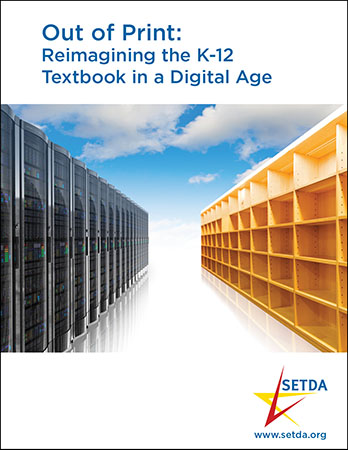Priorities
Digital Content
Out of Print: Reimaging the K-12 Textbook in a Digital Age
The benefits of digital content for student learning are many. Digital content can easily be kept up to date and relevant to students’ lives without the cost of reprinting or redistributing print materials. It can be made available anytime and anywhere, both online and offline, accessible when the student, teacher or parent needs it, whether from home, school, or another location. And digital content can be far richer and engaging, including not only text, but also high-definition graphics, video clips, animations, simulations, interactive lessons, virtual labs and online assessments.
Out of Print makes the case for the digital difference and how digital content can positively affect student learning and engagement, make accommodations for special learning needs, provide unbundled search and discovery, and provide support for personalized learning. It also provides profiles of four states – Indiana, Texas, Utah, and Virginia – and summarizes actions of policymakers from nearly half the states to encourage digital content. Research behind to the paper revealed seven success factors for making the shift to digital content: sustainable funding for devices, robust internet connectivity, up-to-date policies, prepared educators, intellectual property and reuse rights, quality control and alignment to standards, and state and local leadership buy-in. This research led to three recommendations:
- Complete the shift from print-centric textbook adoption practices to digital resources no later than the 2017-18 school year.
- Develop a vision and roadmap for completing this shift that includes eliminating unnecessary regulations and enacting supportive policies, investing in infrastructure and devices to support the shift, and ensuring effective implementation of digital policies.
- Ensure a vibrant marketplace for digital and open content.

- Achieve’s OER Rubrics and Evaluation Tool
- An Expectation of Sharing: Guidelines for Effective Policies to Respect, Protect and Increase the Use of Digital Educational Resources
- Clarifying Ownership of Teacher-Created Digital Content Empowers Educators to Personalize Education, Address Individual Student Needs
- Digital Textbook Playbook
- Rethinking the State Role in Instructional Materials Adoption: Opportunities for Innovation and Cost Savings
- The Accessibility of Learning Content for All Students, Including Students with Disabilities, Must Be Addressed in the Shift to Digital Instructional Materials
